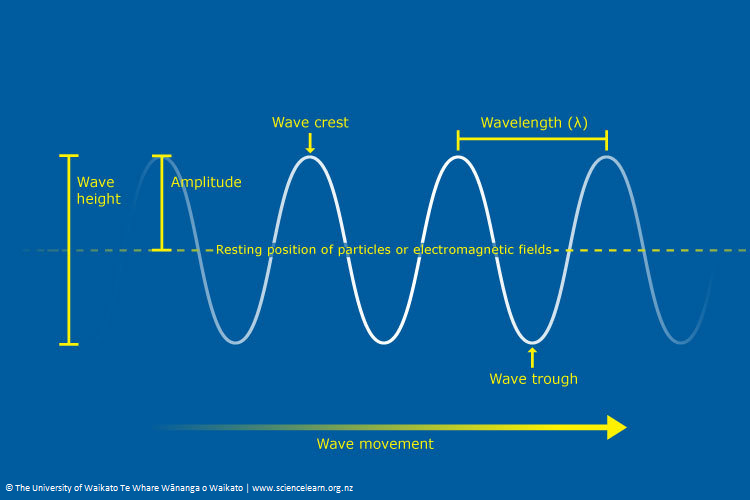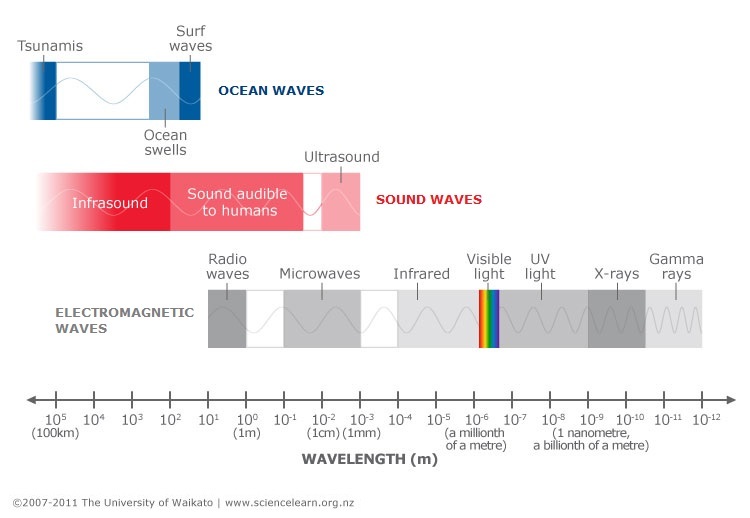Seeing, hearing, feeling warmth, surfing, tuning the radio, using a cellphone – these and many more activities involve waves. But what is a wave? In this article, we get to grips with the different kinds of waves and look at the key characteristics of all waves – their wavelength, period, frequency, speed and amplitude. These concepts are important for describing waves of all kinds.
Different waves, same properties
Water waves are the focus of our tsunamis and surf resources, but many other kinds of wave exist. These include sound waves, light waves, radio waves, microwaves and others. All kinds of waves have the same fundamental properties of reflection, refraction, diffraction and interference, and all waves have a wavelength, frequency, speed and amplitude.
All waves can be thought of as a disturbance that transfers energy.
Some waves (water waves and sound waves) are formed through the vibration of particles. Waves form because water molecules are disturbed, and sound waves are formed by the disturbance of air particles or particles in an object through which sound is travelling, like a door.
Electromagnetic waves (such as light waves, UV radiation, microwaves and others) are formed through oscillating electric and magnetic fields.
Waves have a defined wavelength
Every wave has a specific wavelength. This is defined as the length from one wave crest to the next.
Different kinds of waves have widely varying wavelengths. In water, surf waves have wavelengths of 30–50 m, and tsunamis have much longer wavelengths (about 100km). Sound waves vary in wavelength according to the pitch of the sound – humans can hear sound with wavelengths between 70 mm and 70 m. Different kinds of electromagnetic waves vary greatly in wavelength, from the long wavelength of radio waves (about 10 m) to the much shorter wavelengths of visible light (less than a millionth of a metre – usually described as hundreds of nanometres) and X-rays (less than a billionth of a metre).
Waves have a defined frequency
As well as a defined speed, every wave has a frequency. This is the number of wavelengths that travel past a point in 1 second of time. Frequency is measured in hertz (waves per second). For each type of wave, a longer wavelength means a lower frequency – for electromagnetic waves, for example, microwaves have a much lower frequency than UV waves.
Waves also have a defined period. This is the time it takes for the wave to undergo one complete oscillation or one complete motion. The wave period is inversely proportional to the frequency – the longer the period, the lower the frequency.
Wave speed is related to frequency and wavelength
Every wave travels at a particular speed. Water waves are unusual because waves can have different speeds – wave speed depends on how the wave is formed, which is why tsunamis travel much faster than surf waves. Unlike water waves, electromagnetic waves always travel at the same speed (3 hundred million metres per second) and sound waves all travel at the same speed in a given medium (for example, approximately 340 metres per second in air).
The speed of a wave is related to both its frequency and wavelength. The equation v = f x λ (speed = frequency x wavelength) describes this relationship and is useful for predicting the unknown characteristics of a wave.
For waves that always travel at the same speed (like electromagnetic waves), the equation can be used to work out the frequency or wavelength. High-frequency EM waves will have a short wavelength, and low-frequency waves will have longer wavelengths. For waves with a variable speed (such as water waves), the equation can be used to work out the speed from the frequency and wavelength.
All waves have an amplitude
The amplitude of a wave is normally defined as the maximum displacement of the particles within the wave from their normal equilibrium positions. For water waves, the amplitude of a wave is the distance between the wave crest and the normal water level.
People sometimes talk about the wave height, which is the vertical distance from the wave crest to the wave trough, instead of amplitude.
Nature of science
Common scientific concepts can connect seemingly disparate areas of science. For instance, water waves, sound waves and electromagnetic radiation all exhibit similar characteristics and behaviours. Some of the scientific knowledge obtained in one of these areas can therefore be applied to the others.
Related content
For a more simplified look at waves, see Waves and energy – wave basics.
Activity ideas
Use a Mexican wave to demonstrate how waves transfer energy and to help your students visualise the wave behaviours of reflection, constructive interference and shoaling.
This interactive or paper-based Venn diagram can be used to illustrate the key similarities and differences between tsunami waves and surf waves.
In the electromagnetic spectrum – picture dictation activity, students use a range of skills to investigate some ways humans use the waves on the electromagnetic spectrum.


